Rev.int.med.cienc.act.fís.deporte - número 2 - junio 2001 - ISSN: 1577-0354
Legaz Arrese, A.; Serrano
Ostáriz, E, y Lafuente Bergós, D. (2001). Estudio longitudinal ecocardiográfico de variables y rendimiento en
atletas de élite de media y larga distancia. Revista Internacional de
Medicina y Ciencias de la Actividad Física y el Deporte (2) http://cdeporte.rediris.es/revista/revista2/artcoin.htm
ESTUDIO LONGITUDINAL ECOCARDIOGRÁFICO
DE VARIABLES Y RENDIMIENTO EN ATLETAS DE ELITE DE MEDIA Y LARGA DISTANCIA
LONGITUDINAL
STUDY OF ECHOCARDIOGRAPHIC VARIABLES AND OUTPUT IN LONG AND MIDDLE DISTANCE
ELITE ATHLETES
Alejandro
Legaz Arrese, PhD. a, Enrique Serrano Ostáriz, PhD. a. David Lafuente Bergós.
a Departamento
de Fisiatría y Enfermería de la Universidad de Zaragoza.
Adress:
Alejandro Legaz Arrese
Departamento de Fisiatría y Enfermería
Universidad de Zaragoza
Domingo Mirál s/n. 50009. Zaragoza (España).
Phone
659 392297
.
ABTRACT
The purpose is to establish the relationship between echocardiographic
variables and performance achieved over several years and to determine the
relationship between the degree of dilation and of cardiac hypertrophy.
An echocardiographic study was carried out on 12 men and 12 women to
compete at top-class level in long and middle distance events .They underwent
echocardiographic measurements at least 4 times. An echocardiographic study was
carried out each athlete in each competitive season. The best performance
carried out by the athlete each year was chosen.
LVV/BS (end-diastolic) has a close relationship with performances in
sport, and a highly significant correlation can be found (r > 0.80) in
several athletes, the highest record being very close to that of the best
performance in almost all the athletes. New results show a negative
relationship between hypertrophy evolution (PWT and SWT), and a better
competition speed (r > -0.70) in some of the atheletes.
Key words: Echocardiography, Runners,
Elite, Performance.
TEXT
Introduction
The study of the so called “athlete heart” by means of
echocardiography has been thoroughly investigated. Nevertheless, the main
objective of these studies has been that of characterising and establishing the
limits to physiological adaptation (Serra, 1991; Pellicia et al., 1991; Serra
et al.,). The purpose of this essay is to establish the relationship between
echocardiographic variables and performance achieved over several years and to
determine the relationship between the degree of dilation and of cardiac
hypertrophy.
Materials and Methods
A retrospective analysis was carried out on 12 men and 12 women. They
underwent echocardiographic measurements in the National Centre of Sports
Medicine at least 4 times and were trained to compete at top-class level in
long and middle distance events. An echocardiographic study was carried out on
each athlete in each competitive season using an ecocardiography device (Toshiba
SSH-140ª; Toshiba Medical System S.A. Spain), which produces mono and
two-dimensional images and has a Doppler continuous and colour-coded button.
The echocardiographic variables measured were: left ventricular volume /
body surface ratio (LVV/BS) (end diastolic and end systolic) (ml/m2),
right ventricular diameter (RVD) (mm), posterior wall thickness (PWT) (mm),
septal wall thickness (SWT) (mm) and left auricle diameter (LAD) (mm).
Apart from the merely descriptive analysis showing the relationship between
the echocardiographic variables and the athlete´s performance as expressed
according to the regulations of the IAAF (International Amateur Athletic
Federation) (Spiriev, 1998), Pearson´s correlation was carried out for each
athlete and for each single echocardiographic variable, and these were also
correlated with the IAAF scores. The best performance carried out by the
athlete each year was chosen. The echocardiographic test and the athletic
performance were carried out within a space of 5 months.
Results
Descriptive analysis and correlation among echocardiographic variables.
After graphical representation of all the variables,
only LVV/BS was correlated with performance in competitions. In the following
graphs this correlation is shown.
Figure 1. Graphical representation
of the relationship between left ventricular volume / body surface ratio and
performance (Score IAAF) achieved over several years in male athletes.












In nine out of the 12 male athletes, “athletes 1, 3, 5, 7, 8, 9, 10, 11
and 12”, the highest LVV/BS (end diastolic) values recorded coincide with their
best performances and furthermore, in most of these athletes, the performance
carried out over several years is similar to the LVV/BS (end diastolic).
“Athlete 2” was not active for two years, and over this period, his
LVV/BS (end diastolic) decreased noticeably. After he started training again in
order to compete at top – level, his left ventricular cavity increased, coinciding
with his best personal recor in 800 meters.
Over the first two years of performance, “Atlete 4” considerably
improved his performance considerably in 800 meters along with a similar
increase in LVV/BS (end diastolic), the subsequent reduction in size cavity was
associated to him coming to a standstill in his performance.
Figure 2. Figure 1. Graphical
representation of the relationship between left ventricular volume / body
surface ratio and performance (Score IAAF) achieved over several years in female
athletes.




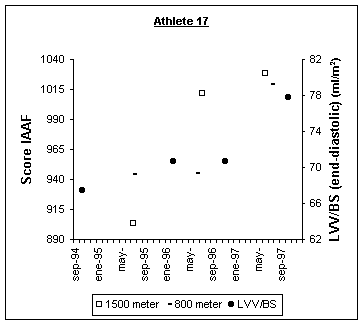


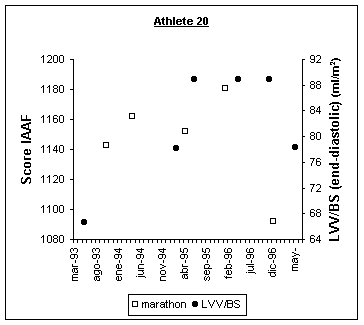

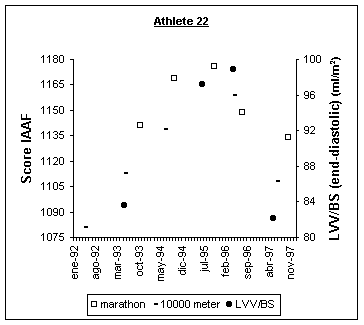
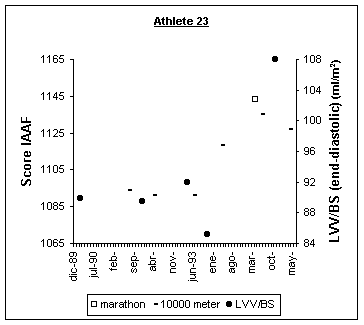
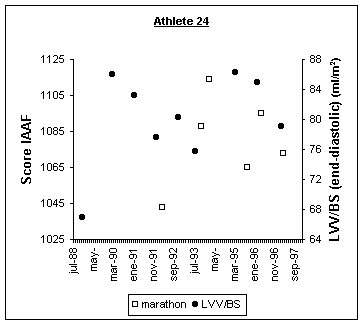
Most female athletes obtain, as do their masculine counterparts, their
personal best performances at approximately the same dates when they get their
highest LVV/BS (en diastolic) measurements and a correlation appears between
LVV/BS (end diastolic) and output.
The rest of the echocardiographic variables behave in a very different
way from LVV/BS (end diastolic), but due to lack of space, their graphic
representation cannot be shown here. Nevertheless, we find it interesting to
show the correlation coefficients found for each athlete between LVV/BS (end
diastolic) and the rest of dimension of the echocardiographic variables (Tables
I and II).
Table II:
Correlation between LVV/BS (end-diastolic) and the rest of the
echocardiographic variables in the female group.
The results found show that the variance observed in the left
ventricular cavity is not correlated to proportional changes in the rest of
heart cavities, such as right ventricular and left auricular cavities.
In seven athletes, “Athletes 1, 3, 8, 13, 16, 23 y 24” LVV/BS was
significatively correlated in a negative way with the PWT and/or SWT, and in
“Athletes 6 and 19” the probablity of signification was very close to 0,05. As
an example, in the following graphics the SWT evolution is shown as related to
these six athlet´s performance.
Figure 3: Figure 1. Graphical
representation of the relationship between septal wall thickness and
performance (Score IAAF) achieved over
several years in six athletes.
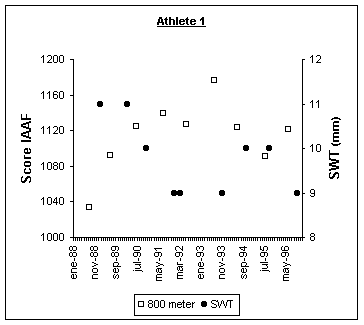
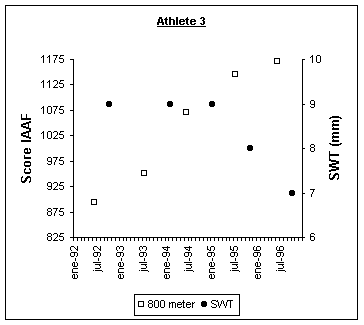
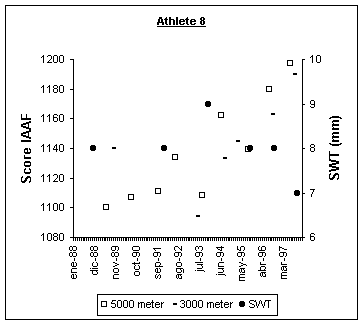
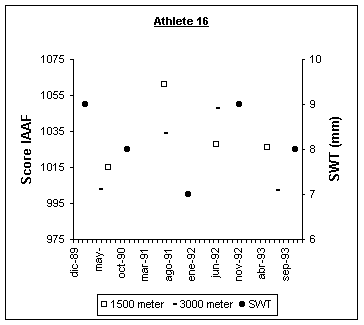
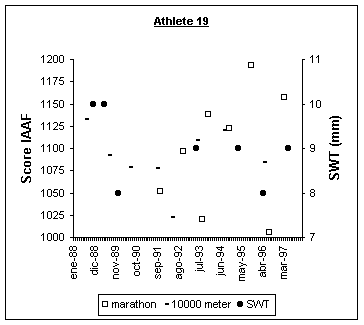
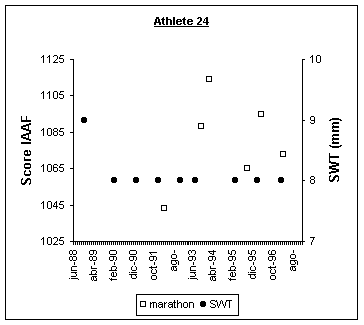
No adaptation in the heart thickness associated to training can be
observed and, from the analysis of the graphics as well as of the statistical
data we can confirm that these small changes are related to important
variations in LVV/BS (end diastolic).
Statistical analysis, correlation of ecocardiographic
variables with performances in competition.
It is very difficult in a study with similar characteristics to this
one, to statistically associate physiological variables with performance:
injuries, athletes specialized in other events, time elapsed between the record
and the valuation, number of measures and performances, and so on. Nevertheless
and despite all these difficulties we have considered that this analysis
provides useful information in orden to confirm the results found in the
graphic representation. In the same way, we feel it is worthwhile showing the
dates that associated cardiographical valuation and performances while
competing. In “Athletes 11, 12, 17, 18 and 23” the analysys couldn´t be made
because we didn´t dispose the 4 measures related to the same competition event.
In “Athletes 7 and 13” this study could only be carried out with the
performance obtained in the second event with the highest IAAF score.
Table
III: Correlation between echocardiographic variables and competition output in
male athletes.
|
|
“Athlete
1”
800
meters
|
“Athlete
2”
800
meters
|
“Athlete
3”
800
meters
|
“Athlete
4”
800
meters
|
“Athlete
5”
1500
meters
|
“Athlete
6”
1500
meters
|
“Athlete
7”
1500
meters
|
“Athlete
8”
5000
meters
|
“Athlete
9”
marathon
|
“Ahtlete
10”
marathon
|
1st
Measure
|
Jan 89 – Aug 88
|
Apr 89 – Jul 89
|
Oct 92 – Jun 92
|
Mar 93 – Aug 92
|
Dec 89 –
Jun 89
|
Feb 90
|
Dec 89 –
Jun 89
|
Nov 88 –
Jun 89
|
May 90 – Sep 91
|
May 93 – Aug 93
|
2nd
Measure
|
Feb 90 – Jun 89
|
Nov 90 – Ago 90
|
Feb 94 – Jul 93
|
Nov 93 –
Jun 93
|
Nov 90 –
Jun 90
|
Nov 90 –
Jun 90
|
Nov 90 – Sep 90
|
Dec 91 – Sep 91
|
May 93 – Oct 93
|
Jun 95 – Feb 95
|
3rd
Measure
|
Nov 90 – Jun 90
|
Oct 93
|
Jan 95 – Jun 94
|
Oct 94 – Jun 94
|
Dec 91 – Jun 91
|
Dec 91 – Jun 91
|
Oct 94 – Jun 94
|
Nov 93 –
Aug 93
|
Mar 95 –
Abr 95
|
Apr 96 –
Dec 95
|
4th
Measure
|
Dec 91 – Jul 91
|
Oct 94 – Jun 94
|
Nov 95 – Jul 95
|
Sep 95 – Jul 95
|
Sep 92 – Jun 92
|
Sep 92 – Jun 92
|
Oct 96 – May 96
|
Sep 95 – Aug 95
|
Dec 95 – Feb 96
|
May 97 – Sep 97
|
|
5th
Measure
|
Mar 92 – Jun 92
|
Oct 95 – Jul 95
|
Oct 96 – Jun 96
|
Oct 96 – May 96
|
Nov 93 – Jun 93
|
Nov 93 – Jul 93
|
Oct 97 – Jul 97
|
Oct 96 – Jul 96
|
May 97 – Ago 97
|
|
|
6th
Measure
|
Nov 93 – Jul 93
|
Sep 96 – Jul 96
|
|
|
Oct 94 – Jul 94
|
Oct 94 – Jul 94
|
|
Oct 97 – Jun 97
|
|
|
|
7th
Measure
|
Oct 94 – Jun 94
|
Oct 97 – Jul 97
|
|
|
Sep 95 – Jun 95
|
Sep 95 – Jul 95
|
|
|
|
|
|
8th
Measure
|
Sep 95 – Jul 95
|
|
|
|
Oct 96 – Jun 96
|
Oct 96 – Jun 96
|
|
|
|
|
|
9th
Measure
|
Oct 96 – Jun 96
|
|
|
|
Oct 97 – Jun 97
|
Oct 97 – Jul 97
|
|
|
|
|
|
LVV/BS
(ml/m2)
(end
diastolic)
Score
IAAF
|
r = 0,84
(9)
**
|
r = -0,58
(6)
|
r = 0,98
(5)
**
|
r = 0,34
(5)
|
r = 0,29
(9)
|
r = 0,58
(8)
|
r = 0,93
(5)
*
|
r = 0,88
(6)
*
|
r = 0,84
(5)
p = 0,077
|
r = 0,96
(4)
*
|
|
LVV/BS
(ml/m2)
(end
systolic)
Score
IAAF
|
r = 0,28
(9)
|
r = -0,31
(6)
|
r = 0,48
(5)
|
r = -0,06
(5)
|
r = 0,61
(9)
p = 0,083
|
r = -0,14
(8)
|
r = 0,17
(5)
|
r = 0,92
(6)
**
|
r = 0,72
(5)
|
r = 0,65
(4)
|
|
RVD (mm)
Score
IAAF
|
r = 0,51
(8)
|
r = 0,55
(5)
|
r = 0,64
(5)
|
r = 0,87
(5)
p = 0,056
|
r = 0,76
(9)
*
|
r = 0,13
(8)
|
r = -0,33
(5)
|
r = -0,28
(5)
|
r = 0,83
(5)
p = 0,079
|
r = 0,11
(4)
|
|
LAD (mm)
Score
IAAF
|
r = 0,39
(8)
|
r = 0,58
(5)
|
r = 0,54
(5)
|
r = -0,30
(5)
|
r = -0,31
(9)
|
r = -0,60
(8)
|
r = 0,06
(5)
|
r = 0,27
(5)
|
r = -0,12
(5)
|
r = 0,40
(4)
|
|
PWT (mm)
Score
IAAF
|
r = -0,80
(9)
**
|
r = 0,20
(6)
|
r = -0,93
(5)
*
|
r = 0,60
(5)
|
r = -0,70
(9)
*
|
r = -0,57
(8)
|
r = 0,37
(5)
|
r = -0,92
(6)
**
|
r = 0,31
(5)
|
r = -0,63
(4)
|
|
SWT (mm)
Score
IAAF
|
r = -0,80
(9)
**
|
r = 0,30
(6)
|
r = -0,81
(5)
p = 0,098
|
r = 0,30
(5)
|
r = -0,70
(9)
*
|
r = -0,35
(8)
|
r = 0,34
(5)
|
r = -0,69
(6)
|
r = 0,21
(5)
|
r = -0,42
(4)
|
LVV/BS = Left ventricular volume / body surface; RVD = Right ventricular
diameter; LAD = Left auricle diameter; PWT = Posterior wall thickness; SWT =
Septal wall thickness.
* p £ 0,05; ** p £ 0,01
The first date corresponds to the moment of the echocardiographic
valuation and the second one to best seasonal record.
A single date corresponds to an echocardiographic valuation that does
not correspond to a close record.
() = echocardiographic measurements numbers
Table III:
Correlation between echocardiographic variables and performances in competition
in the male group.
Table
IV: Correlation between echocardiographic variables and competition output in
female athletes.
|
|
“Athlete
13”
400
meters
|
“Athlete
14”
800
meters
|
“Athlete
15”
1500
meters
|
“Athlete
16”
1500
meters
|
“Athlete
19”
marathon
|
“Athlete
20”
marathon
|
“Athlete
21”
marathon
|
“Athlete
22”
marathon
|
“Athlete
24”
marathon
|
1st
Measure
|
Nov 88 – Jun 88
|
Feb 93 – Jul 92
|
Dec 89 – Feb 90
|
Feb 90 – Jul 90
|
Nov 88
|
May 93 – Oct 93
|
May 93 – Oct 93
|
May 93 – Oct 93
|
Nov 88
|
2nd
Measure
|
Feb 90 – May 89
|
Oct 94 – Jun 94
|
Oct 90
|
Nov 90
|
May 89
|
Feb 95 – Apr 95
|
Mar 95 – Apr 95
|
Jun 95 – Oct 95
|
Feb 90
|
3rd
Measure
|
Jan 91 – May 90
|
Nov 95 – Jul 95
|
Nov 91
|
Dec 91 –
Jul 91
|
Dec 89
|
Jun 95
|
Apr 96 – Feb 96
|
Apr 96 – Jul 96
|
Ene 91
|
4th
Measure
|
Mar 92 – Jul 92
|
Oct 96 – Jul 96
|
Nov 92 – Aug 92
|
Nov 92 – Jun 92
|
May 93 – Aug 93
|
Apr 96 – Jan 96
|
May 97 – Nov 96
|
May 97 – Oct 97
|
Dec 91 – Mar 92
|
|
5th
Measure
|
|
Oct 97 – May 97
|
Oct 93 – Aug 93
|
Nov 93 – May 93
|
Mar 95 – Oct 94
|
Nov 96 – Dec 96
|
|
|
Nov 92
|
|
6th
Measure
|
|
|
Oct 94 – Aug 94
|
|
Apr 96 – Oct 95
|
May 97
|
|
|
Jul 93 – Oct 93
|
|
7th
Measure
|
|
|
Oct 95 – Aug 95
|
|
May 97 – Mar 97
|
|
|
|
Mar 95 – Sep 95
|
|
8th
Measure
|
|
|
Sep 96 – Sep 96
|
|
|
|
|
|
Feb 96 – Apr 96
|
|
9th
Measure
|
|
|
Oct 97 – Aug 97
|
|
|
|
|
|
Feb 97 –
Mar 97
|
|
LVV/BS (ml/m2)
(end
diastolic)
Score
IAAF
|
r = 0,84
(9)
**
|
r = -0,58
(6)
|
r = 0,98
(5)
**
|
r = 0,34
(5)
|
r = 0,29
(9)
|
r = 0,58
(8)
|
r = 0,93
(5)
*
|
r = 0,88
(6)
*
|
r = 0,84
(5)
p = 0,077
|
|
LVV/BS
(ml/m2)
(end
systolic)
Score
IAAF
|
r = 0,28
(9)
|
r = -0,31
(6)
|
r = 0,48
(5)
|
r = -0,06
(5)
|
r = 0,61
(9)
p = 0,083
|
r = -0,14
(8)
|
r = 0,17
(5)
|
r = 0,92
(6)
**
|
r = 0,72
(5)
|
|
RVD (mm)
Score
IAAF
|
r = 0,51
(8)
|
r = 0,55
(5)
|
r = 0,64
(5)
|
r = 0,87
(5)
p = 0,056
|
r = 0,76
(9)
*
|
r = 0,13
(8)
|
r = -0,33
(5)
|
r = -0,28
(5)
|
r = 0,83
(5)
p = 0,079
|
|
LAD (mm)
Score
IAAF
|
r = 0,39
(8)
|
r = 0,58
(5)
|
r = 0,54
(5)
|
r = -0,30
(5)
|
r = -0,31
(9)
|
r = -0,60
(8)
|
r = 0,06
(5)
|
r = 0,27
(5)
|
r = -0,12
(5)
|
|
PWT (mm)
Score
IAAF
|
r = -0,80
(9)
**
|
r = 0,20
(6)
|
r = -0,93
(5)
*
|
r = 0,60
(5)
|
r = -0,70
(9)
*
|
r = -0,57
(8)
|
r = 0,37
(5)
|
r = -0,92
(6)
**
|
r = 0,31
(5)
|
|
SWT (mm)
Score
IAAF
|
r = -0,80
(9)
**
|
r = 0,30
(6)
|
r = -0,81
(5)
p = 0,098
|
r = 0,30
(5)
|
r = -0,70
(9)
*
|
r = -0,35
(8)
|
r = 0,34
(5)
|
r = -0,69
(6)
|
r = 0,21
(5)
|
p £ 0,05; ** p £ 0,01
The first date corresponds to the moment of the echocardiographic
valuation and the second one to best seasonal record.
A single date corresponds to an echocardiographic valuation that does
not correspond to a close record.
() = echocardiographic measurements numbers
Table IV:
Correlation between echocardiographic variables and performances in competition
in the female group.
LVV/BS (end diastolic) was positively related to performance, and a
statistical significance or probabilities close to 0,05 were found in many
athletes. LVV/BS (end systolic) and RVD also change within training seasons,
but hardly any correlation can be found with output, whereas for the LAD no
outstanding changes were found.
In some athletes, their heart thickness was negatively correlated to
output, and this association disappeared when a partial correlation analysis
controlling the influence of the LVV/BS (end diastolic) was carried out.
Discussion
Morganroth et al., (1975) formulated the differential
factor of the type of training on the cardiac viscera and since then there has
been a lot of discussion on the harmonic relationship in the adaptation of
heart thickness and cavities in sprinters and long-distance runners (Ikäeimo et
al., 1979; Fisher et al., 1989; Elias et al., 1991; Calderon, 1993).
Perrault and Turcotte (1994) by means of using data from
echocardiographic researches carried out the last 20 years on 1000 athletes and
800 subjects and from the differences found in longitudinal studies which
lasted between 4 and 52 weeks, question the changes in cardiac morphology
induced by training due to the fact that the differences found in the PWT are
below technical resolution and to the fact that increases in this left
ventricular cavity are close to resolution and furthermore, their measure can
be affected by the effects of bradicardia and by the expansion of the volume of
plasma.
In a number of subjects, heterogeneity in sport and output included in
the same sample, antropometric variation, differents measure units, short
duration longitudinal studies and errors associated to measure techniques, are
the causes for the controversy over cardiac adaptaction to training.
This study shows that in top – class athletes, cardiac dimensions change
with training seasons as an adaptation to aerobic training and that increases
in the left ventricular cavity do not go together with similar increases in the
rest of cavities. These variances are much higher than the ones atributed to
the limitation of technical resolution and to changes in the basal cardiac
frequency and to the volume of plasma.
On the contrary, in athletes of this category, heart thickness does not
change very much, and the small changes are associated to changes in LVV/BS
(end diasstolic), a high increase in LVV/BS (en diastolic) produces a streching
of the left ventricular whic produces a thinning in the ventricular walls, the
same effect as the one produced by blowing up a balloon (Perrault and Turcotte,
1994).
The main achievement in this essay is having proved that the LVV/BS is
related to the sport score. In a side investigation that remains unpublished, a
sample formed by 135 male athletes was classified according to their events and
despite the fact that in every group the variance coefficient of the
performance was below 3%, the LVV and the LVV/BS (end diastolic) were
significatively correlated to the competition speed in almost every distance.
We would also like to highlight that in this same project, the VO2 max
(ml.kg-1.min-1) was not correlated in any of the groups
neither with the performance nor with the LVV/BS (end diastolic). The same
results were found when carrying out a longitudinal analysis with these same
athletes in this essay. As a result, the influence that the LVV/BS (end
diastolic) has on the sport score is subject to different mechanisms from the
maximal oxygen uptake: functional economy and cost of oxygen, termoregulation,
blood distribution, disposal of metabolism derived products (lactate, CO2),
recovery processes, etc.
Conclusion
Endurance training produces a high increase in heart
cavities even in high level athletes, especially in left ventricular
dimensions. However, changes induced by training in heart thickness are
insignificant and their changes are linked to significant variations in LVV
(end diastolic).
This study proves that LVV/BS (end diastolic) is closely related to
output in competition, and using support from other studies we are carrying
out, we can state that this variable has among homogeneous groups, a higher
predicitive power tah that of some other variables traditionally evaluated.
REFERENCES
Calderon FJ (1993). Análisis
comparativo mediante ecocardiografía Doppler color entre atletas de resistencia
y velocidad. Tesis Doctoral.
Facultad de Medicina (Universidad Complutense de Madrid)
Elias BA, Berg KE, Latin RW, Mellion MB, Hofschire PJ (1991). Cardiac
structure and function in weight trainers, runners, and runner/weight trainers.
Res Q Exerc Sports. 62 (3): 326-332.
Fisher AG, Adams T, Yanowitz F, Ridges JD, Orsmond G (1989). Noninvasive
evaluation of world class athletes engaged in different modes of training. Am J Cardiol. 63: 337-341
Ikäheimo MJ, Palatsi IJ, Takkunen JT (1979). Noninvasive evaluation of
the athletic heart: sprinters versus endurance runners. Am J Cardiol. 44: 24-30
Morganroth J, Maron HJ, Henry WL, Epstein SE (1975). Comparative left
ventricular dimensions, volumes and performance. Ann Intern Med. 82:
521-524.
Pelliccia A, Barry J, Maron D, Spataro A, Proschan M, Spirito P (1991).
The upper limit of physiologic cardiac hypertrophy in highly trained elite
athletes. N Engl J Med. 324:
295-301.
Perrault H, Turcotte RA (1994). Exercice-induced cardiac hypertrophy.
Fact or fallacy?. Sports Med. 17 (5): 288-308
Serra R (1991). Diagnóstico y valoración clínica de la hipertrofia
ventricular izquierda en atletas. Archivos
de Medicina del Deporte. 32:
331-333.
Serra R, Ferrés P, Garrido E, Prat
T, Carrió I (1994). Valoración de la hipertrofia ventricular izquierda en
deportistas con ecocardiograma y antimiosina. Archivos de Medicina del Deporte.
42: 127-131.
Spiriev B (1998). IAAF scoring
tables of athletics. IAAF .
Rev.int.med.cienc.act.fís.deporte - número 2 - junio 2001 - ISSN: 1577-0354





























